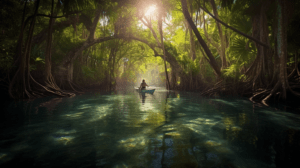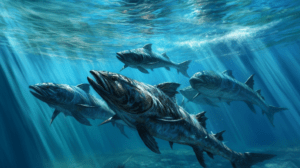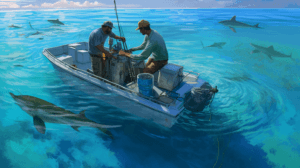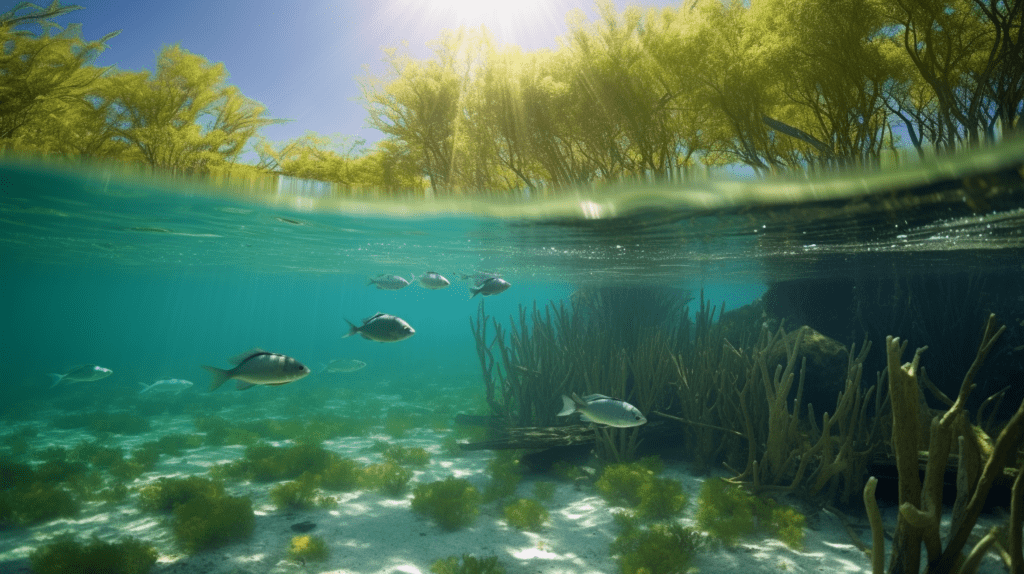Are you looking to catch a Tarpon? To increase your chances of success, it’s important to understand their behavior and habitat.
Tarpon are known for their acrobatic jumps and impressive size, making them a prized catch among anglers. They can be found in warm coastal waters around the world, but identifying their ideal habitats is crucial for a successful fishing trip.
Tarpon are typically found in shallow coastal waters such as bays, estuaries, and mangrove-lined lagoons. Their preferred habitat includes areas with structure such as docks, bridges, and submerged vegetation. These structures provide cover for the Tarpon and attract smaller fish which they feed on.
Understanding these factors will help you locate ideal tarpon habitats for fishing. In this article, we will explore some key considerations when identifying ideal tarpon habitats including:
- water temperature and depth
- weather conditions
- local knowledge and expertise
- safety precautions
- regulations and conservation efforts
These should be taken into account before embarking on your next fishing expedition.

- Key Takeaways
- Understanding Tarpon Behavior
- Identifying Ideal Tarpon Habitats
- Water Temperature and Depth
- Weather and Tidal Conditions
- Fishing Techniques and Equipment
- Local Knowledge and Expertise
- Safety Precautions
- Regulations and Licensing
- Conservation and Sustainability
-
Frequently Asked Questions
- What is the best time of day to fish for tarpon in ideal habitats?
- Are there any specific lures or baits that work best for tarpon in these habitats?
- How do tarpon react to changes in water temperature and depth?
- Are there any particular weather patterns that make tarpon more active in their habitats?
- What are some common mistakes that novice anglers make when fishing for tarpon in ideal habitats?
- Conclusion
Key Takeaways
- Tarpon prefer warm coastal waters with structure and can be found worldwide.
- They inhabit shallow flats as juveniles and deeper waters as adults, and are attracted to bridges, channels, and deep holes.
- Ideal water temperature for tarpon is between 75-85‚°F, and factors such as wind direction, moon phase, water clarity, and current strength impact their feeding habits.
- Local knowledge and guidance from experts and guides can help identify ideal habitats and increase success rate in tarpon fishing.
Understanding Tarpon Behavior
Understanding tarpon behavior is key to finding the best fishing spots, so it’s important to know when and where they feed. Tarpon migration is a crucial factor that affects their feeding patterns. These fish travel long distances to find food sources, often moving from saltwater to freshwater habitats.
During the summer months, large numbers of tarpons migrate along the Gulf of Mexico and Atlantic coasts.
Tarpon are also known for their feeding patterns, which can change depending on factors such as water temperature, light levels, and tide movements. They primarily feed on small baitfish such as mullet or sardines and prefer areas with plenty of underwater structure like mangrove shorelines or bridges.
Juvenile tarpons tend to inhabit shallow flats while larger ones prefer deeper waters.
To increase your chances of catching a tarpon, it’s important to understand their behavior and habitat preferences. Look for areas where there are plenty of baitfish present or schools of mullet jumping out of the water.
Also keep an eye out for areas with strong currents or tidal movements as these can create feeding opportunities.
Understanding tarpon behavior is essential in identifying ideal fishing spots. By learning about their migration patterns and feeding habits, you can pinpoint locations where they are likely to be found.
The next section will delve further into how you can identify specific habitats that are more likely to hold these prized game fish without having to rely purely on luck or chance encounters at random spots in the waterways!
Identifying Ideal Tarpon Habitats
One way to pinpoint the best spots for catching tarpon is by observing their behavior in relation to the environment. Tarpon tend to prefer certain geographical features, such as bridges, channels, and deep holes. These structures create areas of turbulence that attract baitfish and other prey, making them prime hunting grounds for tarpon.
In addition to geographical features, understanding tarpon’s bait preferences can also help identify ideal habitats. Tarpon are known to feed on a variety of prey including crabs, shrimp, and small fish. When scouting for tarpon hotspots, look for areas where these types of bait are abundant.
It’s important to note that ideal tarpon habitats may vary based on location and season. For example, in Florida during the summer months when water temperatures are high, tarpon may move into deeper waters seeking cooler temperatures. Therefore, paying attention to changes in water temperature and depth can also be key in identifying prime fishing locations.
By taking note of geographical features favored by tarpon and keeping track of their preferred prey species and water conditions throughout the year, you can increase your chances of finding ideal habitats for these sought-after gamefish. Now let’s discuss how water temperature and depth impact tarpon behavior.
Water Temperature and Depth
When the summer sun beats down on Florida waters, tarpon seek out deeper areas where the temperature is cooler. This behavior is due to their sensitivity to temperature fluctuations and seasonal patterns in water temperatures. The ideal water temperature for tarpon is between 75°F and 85°F, and they tend to move towards deeper waters when the surface temperature exceeds this range.

Tarpon are known to inhabit different water depths depending on the time of day and various environmental factors. During the early morning or late evening hours, they are more likely to be found in shallow waters close to shorelines or around structures such as piers, jetties, and docks. However, as the day progresses and temperatures rise, tarpon move into deeper offshore waters with cooler temperatures.
It’s important for anglers targeting tarpon to focus on finding areas with a consistent depth range that falls within these ideal water temperatures. Typically, fishing in deep channels or near thermoclines where there is a sudden change in temperature can increase your chances of hooking a tarpon. It’s also crucial to pay attention to tidal movements as they can affect water temperatures by bringing in cooler or warmer currents.
Understanding how water temperature and depth influence tarpon behavior can significantly increase your success rate when fishing for them. In addition to these factors, weather conditions such as wind speed and direction also play a role in determining feeding habits of these fish species. As we move onto discussing weather and tidal conditions in the next section, it’s essential not only to consider individual factors but also how they interact with each other when identifying ideal habitats for catching tarpons.

Weather and Tidal Conditions
Weather and tidal conditions greatly impact the feeding habits of tarpon, making it crucial for anglers to pay attention to these factors when planning their fishing trips.
Wind direction is an important factor to consider, as tarpon tend to feed in areas where the wind pushes baitfish towards them. For example, if the wind is blowing from the north, try fishing on southern shorelines or vice versa.
Additionally, moon phase can also play a role in tarpon feeding patterns. During a full or new moon, tides are stronger and can push baitfish towards shorelines and structures where tarpon may be waiting.
Another important factor to keep in mind is water clarity. Tarpon prefer clear water with good visibility, so avoid fishing in areas with murky or dirty water.
Current strength is also important; too much current can make it difficult for tarpon to locate and catch prey while too little current can disperse baitfish away from prime feeding areas.
When taking into account all of these weather and tidal conditions, it’s also important to match your fishing techniques and equipment accordingly. Consider using lures that mimic the type of baitfish present in the area you are targeting and adjust your retrieve speed depending on how active the fish are at that time.
When casting near structures such as docks or bridges, use heavier line and leader material to avoid losing fish in structure.
By paying close attention to weather patterns like wind direction and moon phase as well as considering water clarity and current strength when selecting fishing locations, anglers increase their chances of successfully landing tarpon. With proper technique adjustments based on these factors, you’ll be well on your way to catching one of these magnificent game fish!
Fishing Techniques and Equipment
To improve your chances of catching tarpon, you’ll need to adjust your techniques and equipment based on the conditions of the water.
One important aspect to consider is bait selection. Tarpon are known for their pickiness when it comes to food, so choosing the right bait can make or break your fishing trip. Common baits include live crabs, shrimp, and mullet. Additionally, artificial lures such as plugs and jigs can also be effective.
Casting techniques are another crucial factor in tarpon fishing success. When casting for tarpon, accuracy and distance are key. A long cast can increase your chances of hooking a fish while a shorter but more accurate cast may be necessary if there are obstacles in the way such as mangroves or other boats. It’s important to practice these techniques before heading out on a fishing trip to ensure you’re comfortable with them.
When it comes to equipment, having the right gear is essential for tarpon fishing. A sturdy rod with a high weight capacity is necessary as tarpon can weigh over 100 pounds and put up a fight when hooked. Heavy-duty reels with strong drag systems are also important as they will help prevent line breaks during a fight with a large fish.

Local knowledge and expertise play an important role in identifying ideal tarpon habitats for fishing. By understanding where these fish typically feed and spawn, local experts can provide valuable guidance on where to find them at different times of day or year. With this knowledge combined with proper bait selection, casting techniques, and equipment, you’ll be well-equipped for an exciting day of tarpon fishing.
Local Knowledge and Expertise
Don’t miss out on the valuable insights and tips that local experts can provide for maximizing your chances of a thrilling tarpon fishing experience.
Interviewing locals who have been fishing in the area for years is one way to gain knowledge about ideal tarpon habitats.
Fishing communities are also great resources for gathering information about where tarpons can be found at different times of the year.
Local knowledge can help you pinpoint the best spots for your next fishing expedition.
Experienced anglers know that factors such as water temperature, tide patterns, and currents play crucial roles in identifying prime tarpon habitats.
They can also advise you on what time of day or night yields the highest success rates.
When it comes to fishing, relying solely on equipment and techniques may not be enough to guarantee a successful catch.
Local expertise provides unique perspectives on how to read and interpret natural signs that indicate where tarpons are likely to congregate.
Fishing with an experienced guide who has firsthand knowledge of these locations could significantly increase your chances of reeling in a trophy-sized fish.
While local knowledge is essential for finding ideal tarpon habitats, safety precautions should also be taken seriously before heading out on any fishing trip.
Always check weather forecasts and ensure that all necessary safety equipment is onboard before setting sail.
With proper preparation and guidance from local experts, you’ll be well-equipped to embark on an unforgettable tarpon-fishing adventure!
Safety Precautions
Transition: Now that you’ve gained local knowledge and expertise on tarpon habitats, it’s important to keep safety precautions in mind during your fishing trip.
Current Subtopic: Safety Precautions
Fishing for tarpon can be an exhilarating experience, but it’s important to prioritize safety while out on the water. Emergency procedures should be discussed with everyone onboard prior to setting off. Make sure all passengers know where emergency equipment is located and how to use it. It’s also worth reviewing basic first aid techniques with your group.
Boat safety is crucial when fishing for tarpon. Always make sure everyone onboard is wearing a life jacket, regardless of their swimming ability. Life jackets should fit properly and be worn at all times while out on the water. Additionally, ensure that there are enough life jackets for every passenger onboard.
Incorporating a checklist into your pre-trip routine can help ensure boat safety. The table below outlines some key items you should consider before heading out onto the water.
| Boat Safety Checklist | |
|---|---|
| Check weather forecast | Check for rough waters or storms |
| Ensure proper fuel levels | Running out of gas could leave you stranded |
| Inspect boat equipment | Check lights, horn, radio, etc. |
| Pack necessary gear | First aid kit, sunscreen, food & water |
Remember that regulations regarding boating safety vary by state and territory – always check local laws before heading out on the water.
Transition: With these safety precautions in mind, it’s time to explore regulations and licensing requirements when fishing for tarpon.
Regulations and Licensing
Before embarking on your tarpon fishing adventure, it’s important to understand the local fishing laws and regulations in the area.
This includes obtaining any required permits and licenses necessary for legal fishing. Failure to comply with these laws can result in fines or even criminal charges, so it’s essential to research and follow all relevant guidelines before setting out on your trip.
Understanding Local Fishing Laws
Knowing the local fishing laws is crucial for any angler looking to catch tarpon in their ideal habitats. Failure to adhere to these regulations can result in hefty fines or even legal consequences.
Here are some key points that every angler should keep in mind when fishing for tarpon:
- Permit requirements: Depending on where you plan on fishing, you may need a permit from the state or federal government. These permits often come with specific regulations surrounding gear, catch limits, and release protocols.
- Fishing restrictions: Certain areas may have restrictions on when and where you can fish for tarpon. For example, there may be seasonal closures or designated no-fishing zones.
It’s important to do your research and understand the local laws before heading out on your fishing trip. By doing so, you’ll not only avoid any legal trouble but also help protect the tarpon population for future generations.
When it comes to obtaining required permits and licenses, there are a few different options available depending on your location and circumstances. The most common types of permits include recreational fishing licenses and commercial fishing licenses. Be sure to check with your local wildlife agency or fisheries department to determine which permits are required for your specific situation.
Obtaining Required Permits and Licenses
To legally fish for these majestic creatures, anglers must obtain the necessary permits and licenses from their local wildlife agency or fisheries department.
The application process may vary depending on the location, but generally, applicants will need to provide personal information and pay a fee.
Additionally, many jurisdictions have legal requirements that must be met before a permit can be issued. These requirements may include completing a fishing education course or adhering to specific catch-and-release regulations.
It’s essential for anglers to familiarize themselves with their state’s regulations and guidelines before applying for any permits or licenses. Once obtained, it’s crucial to adhere to all rules and regulations set forth by the issuing agency in order to legally fish for tarpon while also promoting conservation and sustainability of this species’ population.
Conservation and Sustainability
You can’t ignore the importance of conservation and sustainability when it comes to finding the perfect tarpon fishing spot.
Tarpon are a crucial part of the ecosystem, and their population must be protected for future generations. This is where community involvement plays a critical role in ensuring that the species remains sustainable.
Eco-tourism is an essential aspect of tarpon conservation. Many areas that serve as prime tarpon habitats also attract tourists who want to see these magnificent creatures up close. These visitors bring money into local economies and create jobs, but they can also have a detrimental impact on the environment if not managed correctly.
By promoting responsible eco-tourism practices, we can ensure that both humans and wildlife benefit from tourism while preserving natural resources.
When fishing for tarpon, it’s important to use catch-and-release methods whenever possible. This means handling fish carefully and returning them back into the water as quickly as possible without causing harm or stress. Anglers should also avoid using non-biodegradable materials when fishing, such as plastic lures or hooks that could end up harming other marine life.
It’s essential to follow all local regulations regarding tarpon fishing. Regulations exist to protect the species and ensure its sustainability for future generations. By following these rules, anglers contribute directly to conservation efforts by not overfishing or exploiting this valuable resource beyond what is sustainable for its long-term survival.
In conclusion, finding an ideal tarpon habitat requires an understanding of how conservation and sustainability intersect with community involvement and eco-tourism. By practicing responsible angling techniques and adhering to local regulations, we can help preserve this majestic species while still enjoying all that it has to offer anglers around the world.
Frequently Asked Questions
What is the best time of day to fish for tarpon in ideal habitats?
To catch tarpon, fish during high tide in the early morning or evening. Use live bait and heavy tackle, such as a 6-8 foot rod with 50-80 lb test line. Locate tarpon schools by understanding their migration patterns and using sonar equipment.
Are there any specific lures or baits that work best for tarpon in these habitats?
To catch tarpon, the lures vs. bait debate is ongoing. Tarpon feeding behavior varies by location and time of day, so experiment with different options like live bait or flashy lures to determine what works best in specific habitats.
How do tarpon react to changes in water temperature and depth?
Tarpon behavior during spawning season is affected by changes in water temperature and depth. Salinity levels also impact their feeding habits. Scientific data shows that understanding these factors can improve fishing success.
Are there any particular weather patterns that make tarpon more active in their habitats?
Tarpon migration is often triggered by changes in weather patterns such as barometric pressure and wind direction. However, pollution can have a negative impact on their behavior and habitat selection, leading to decreased activity and avoidance of certain areas.
What are some common mistakes that novice anglers make when fishing for tarpon in ideal habitats?
Novice anglers often make common mistakes when fishing for tarpon in ideal habitats. They underestimate the tarpon’s strength, lack proper gear, and fail to read tarpon behavior cues. Understanding these factors is crucial for successful tarpon fishing.
Conclusion
In conclusion, identifying ideal tarpon habitats for fishing requires a thorough understanding of their behavior and habitat preferences. Factors such as water temperature, depth, weather conditions, tidal patterns, and local knowledge play crucial roles in determining the location of these elusive game fish.
Additionally, it’s important to use appropriate fishing techniques and equipment while adhering to safety precautions and regulations. To ensure sustainable fishing practices, it’s important to consider conservation efforts aimed at protecting these species. This includes obtaining necessary licenses and permits while minimizing the impact on their natural environment.
By following these guidelines, anglers can enjoy a rewarding tarpon fishing experience while contributing to the preservation of this iconic species for future generations.


Pingback: Unraveling The Mystery Of Tarpon: A Closer Look At Their Biology - Fishing For Tarpon
Pingback: Tarpon Fish: Visual Identification And Common Misconceptions - Fishing For Tarpon